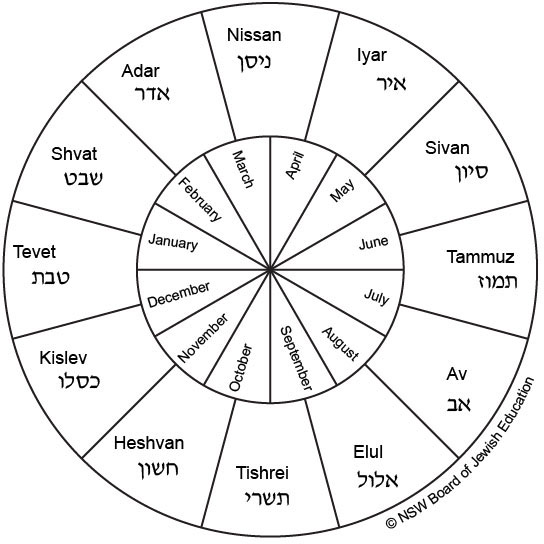The Jewish calendar is different to the one we use in Australia (called the ‘secular calendar’ or ‘common calendar’). The secular calendar is based on the earth going around the sun, but the Jewish calendar is based on the moon going around the earth. That is why we also call it the ‘lunar’ calendar (the word ‘lunar’ tells us it has something to do with the moon). It takes the moon 29 1/2 days to go around the earth once (a lunar month). The lunar year has 354 days (12 x 29 1/2) and the secular year has 365 days. By adding an extra month in the lunar year (when it is a leap year), the lunar calendar stays in step with the seasons just like the solar calendar does (it gets an extra day once every 4 years when it is ‘leap year’). This is important because we are told in the Torah that Pesach is a spring festival (it always takes place in spring), and that means that the Jewish month of Nissan (when Pesach takes place) must always be in the season of spring.
The names of the Jewish calendar’s months are all in Hebrew and come from the Babylonian calendar, from a very long time ago. The first Jewish calendar was written by a man named Hillel II.
The first month of the Jewish calendar is called ‘Nissan’ and is spring in Israel. The Jewish New Year, however, is in Tishrei (which is the seventh month). This is not so strange: think about how the Australian new year begins in January, but the Chinese new year begins a month or two later. So, the Jewish calendar has different starting points for different reasons.
The beginning day/s of each month are very important in the Jewish calendar. We call these days ‘new moon’ days. They are called ‘Rosh Chodesh’ (‘Head of the Month’) in Hebrew. On the Saturdays before the beginning of the new month, and on the actual days of the new month, we say special prayers.

The months of the Jewish year are:
- Nissan
- Iyar
- Sivan
- Tammuz
- Av
- Elul
- Tishrei
- Cheshvan
- Kislev
- Tevet
- Sh’vat
- Adar
When it is a leap year in the Jewish calendar we add in an entire extra month called Adar Sheni or Second Adar.


